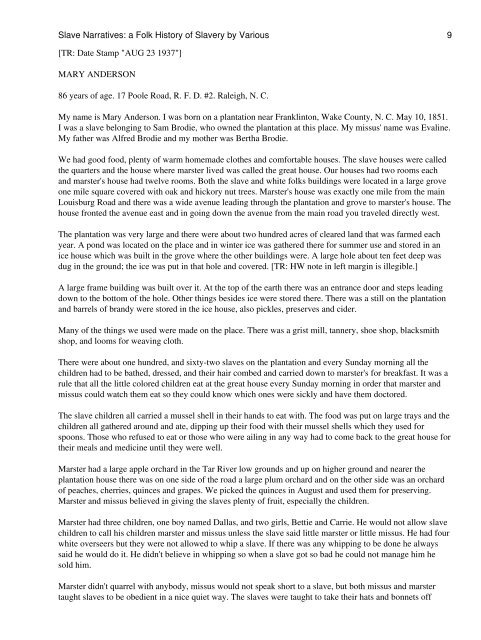Slave Narratives: a Folk History of Slavery in the United States
Slave Narratives: a Folk History of Slavery in the United States
Slave Narratives: a Folk History of Slavery in the United States
Create successful ePaper yourself
Turn your PDF publications into a flip-book with our unique Google optimized e-Paper software.
<strong>Slave</strong> <strong>Narratives</strong>: a <strong>Folk</strong> <strong>History</strong> <strong>of</strong> <strong>Slave</strong>ry by Various 9[TR: Date Stamp "AUG 23 1937"]MARY ANDERSON86 years <strong>of</strong> age. 17 Poole Road, R. F. D. #2. Raleigh, N. C.My name is Mary Anderson. I was born on a plantation near Frankl<strong>in</strong>ton, Wake County, N. C. May 10, 1851.I was a slave belong<strong>in</strong>g to Sam Brodie, who owned <strong>the</strong> plantation at this place. My missus' name was Eval<strong>in</strong>e.My fa<strong>the</strong>r was Alfred Brodie and my mo<strong>the</strong>r was Bertha Brodie.We had good food, plenty <strong>of</strong> warm homemade clo<strong>the</strong>s and comfortable houses. The slave houses were called<strong>the</strong> quarters and <strong>the</strong> house where marster lived was called <strong>the</strong> great house. Our houses had two rooms eachand marster's house had twelve rooms. Both <strong>the</strong> slave and white folks build<strong>in</strong>gs were located <strong>in</strong> a large groveone mile square covered with oak and hickory nut trees. Marster's house was exactly one mile from <strong>the</strong> ma<strong>in</strong>Louisburg Road and <strong>the</strong>re was a wide avenue lead<strong>in</strong>g through <strong>the</strong> plantation and grove to marster's house. Thehouse fronted <strong>the</strong> avenue east and <strong>in</strong> go<strong>in</strong>g down <strong>the</strong> avenue from <strong>the</strong> ma<strong>in</strong> road you traveled directly west.The plantation was very large and <strong>the</strong>re were about two hundred acres <strong>of</strong> cleared land that was farmed eachyear. A pond was located on <strong>the</strong> place and <strong>in</strong> w<strong>in</strong>ter ice was ga<strong>the</strong>red <strong>the</strong>re for summer use and stored <strong>in</strong> anice house which was built <strong>in</strong> <strong>the</strong> grove where <strong>the</strong> o<strong>the</strong>r build<strong>in</strong>gs were. A large hole about ten feet deep wasdug <strong>in</strong> <strong>the</strong> ground; <strong>the</strong> ice was put <strong>in</strong> that hole and covered. [TR: HW note <strong>in</strong> left marg<strong>in</strong> is illegible.]A large frame build<strong>in</strong>g was built over it. At <strong>the</strong> top <strong>of</strong> <strong>the</strong> earth <strong>the</strong>re was an entrance door and steps lead<strong>in</strong>gdown to <strong>the</strong> bottom <strong>of</strong> <strong>the</strong> hole. O<strong>the</strong>r th<strong>in</strong>gs besides ice were stored <strong>the</strong>re. There was a still on <strong>the</strong> plantationand barrels <strong>of</strong> brandy were stored <strong>in</strong> <strong>the</strong> ice house, also pickles, preserves and cider.Many <strong>of</strong> <strong>the</strong> th<strong>in</strong>gs we used were made on <strong>the</strong> place. There was a grist mill, tannery, shoe shop, blacksmithshop, and looms for weav<strong>in</strong>g cloth.There were about one hundred, and sixty-two slaves on <strong>the</strong> plantation and every Sunday morn<strong>in</strong>g all <strong>the</strong>children had to be ba<strong>the</strong>d, dressed, and <strong>the</strong>ir hair combed and carried down to marster's for breakfast. It was arule that all <strong>the</strong> little colored children eat at <strong>the</strong> great house every Sunday morn<strong>in</strong>g <strong>in</strong> order that marster andmissus could watch <strong>the</strong>m eat so <strong>the</strong>y could know which ones were sickly and have <strong>the</strong>m doctored.The slave children all carried a mussel shell <strong>in</strong> <strong>the</strong>ir hands to eat with. The food was put on large trays and <strong>the</strong>children all ga<strong>the</strong>red around and ate, dipp<strong>in</strong>g up <strong>the</strong>ir food with <strong>the</strong>ir mussel shells which <strong>the</strong>y used forspoons. Those who refused to eat or those who were ail<strong>in</strong>g <strong>in</strong> any way had to come back to <strong>the</strong> great house for<strong>the</strong>ir meals and medic<strong>in</strong>e until <strong>the</strong>y were well.Marster had a large apple orchard <strong>in</strong> <strong>the</strong> Tar River low grounds and up on higher ground and nearer <strong>the</strong>plantation house <strong>the</strong>re was on one side <strong>of</strong> <strong>the</strong> road a large plum orchard and on <strong>the</strong> o<strong>the</strong>r side was an orchard<strong>of</strong> peaches, cherries, qu<strong>in</strong>ces and grapes. We picked <strong>the</strong> qu<strong>in</strong>ces <strong>in</strong> August and used <strong>the</strong>m for preserv<strong>in</strong>g.Marster and missus believed <strong>in</strong> giv<strong>in</strong>g <strong>the</strong> slaves plenty <strong>of</strong> fruit, especially <strong>the</strong> children.Marster had three children, one boy named Dallas, and two girls, Bettie and Carrie. He would not allow slavechildren to call his children marster and missus unless <strong>the</strong> slave said little marster or little missus. He had fourwhite overseers but <strong>the</strong>y were not allowed to whip a slave. If <strong>the</strong>re was any whipp<strong>in</strong>g to be done he alwayssaid he would do it. He didn't believe <strong>in</strong> whipp<strong>in</strong>g so when a slave got so bad he could not manage him hesold him.Marster didn't quarrel with anybody, missus would not speak short to a slave, but both missus and marstertaught slaves to be obedient <strong>in</strong> a nice quiet way. The slaves were taught to take <strong>the</strong>ir hats and bonnets <strong>of</strong>f
















